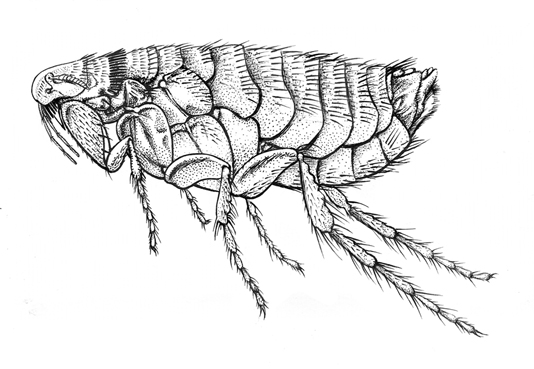Siphonaptera - The Fleas
Somewhere in the dim past, perhaps about 160 million years ago, fleas evolved from their Mecopteran ancestors. Comprising the order called Siphonaptera, the ordinal name means “wingless siphon”. This description is due to their habit of being bloodsuckers who have lost the power of true flight and live on or near their host, a habit that has made fleas a “big” nuisance. Heard of the Black Plague that killed off a third of Europe’s population in the 14th century? That was caused by a bacterium (Yersinia pestis) carried by fleas (who transmitted the disease to humans), which were distributed via rats. Fleas are quite small, 1-9mm (0.04-0. 33"), with bodies flattened on the vertical. They have backward-pointing bristles on their bodies and "swim" through the hairs on their hosts. Even more impressive is their ability to easily jump a hundred times there own body length at any given moment. This is allowed because of a fabulous internal structure called a pleural arch, constructed of an even more amazing material, called resilin. Resilin is an elastic protein that is extremely efficient, releasing as much as 97% of stored energy! This energy is directed into the legs, which, in preparation for “flight” are held raised up against the body. Upon unlocking of the trochanters, the flea will accelerate 200 gravities, faster than the human eye can perceive! This apparatus is quite mechanical, requiring no potential muscle energy and capable of performing just as well in the freezing cold as in the blazing heat. A flea can jump 600 times or more in an hour while it searches out a host! Like mosquitoes, they can track the carbon dioxide signatures of their hosts. There are about 2,000 known species, only ten percent preying on birds (mostly seabirds and a few perching birds, especially swallows and martins, with 19 species of fleas associated with those two birds alone!). The rest feed on mammals. Very few of humankind’s furry brethren have escaped the piercing stylets of fleas. A few species that seem to often be flea-free are: aquatic mammals, flying lemurs, zebras, rhinos, aardvarks and primates. Fleas generally rely on mammalian hosts who build nests, for they have a larval stage dependent on their parents for blood nourishment.

Illustration by Andrea Gonzalez
